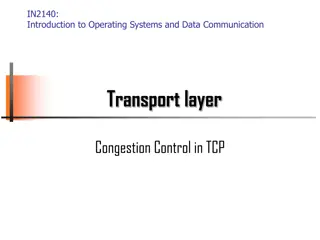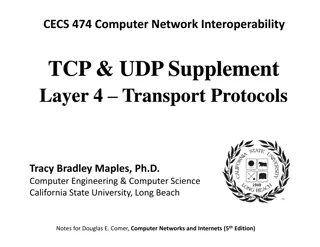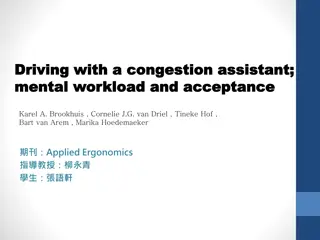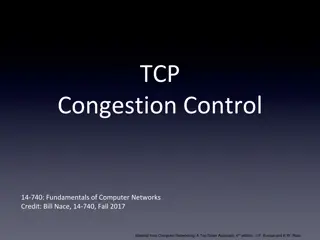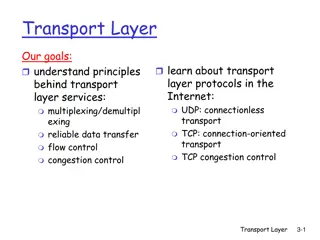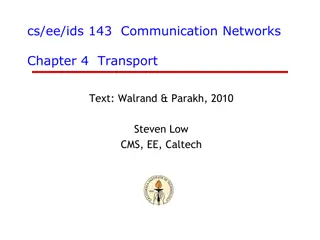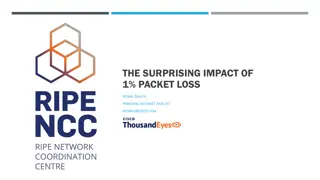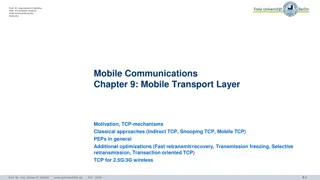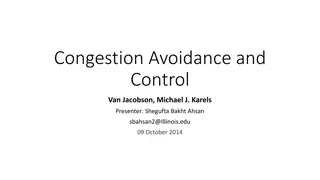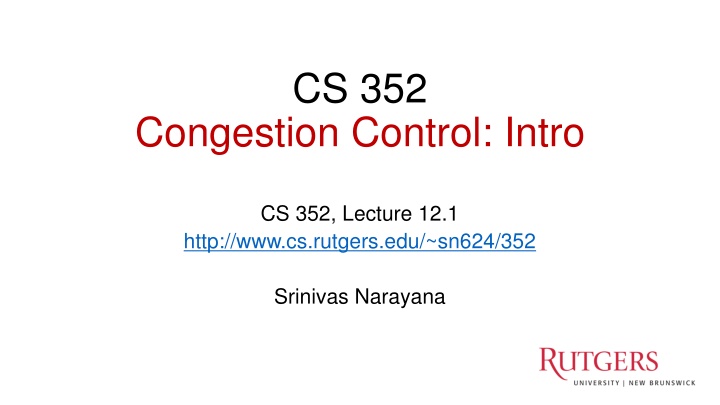
Congestion Control in Computer Networks
Learn about congestion control in computer networks, including how applications achieve performance guarantees, the effects of congestion on data transmission, and how multiple endpoints share network resources. Explore the distributed algorithm used by the Internet to ensure fair and efficient network usage.
Download Presentation

Please find below an Image/Link to download the presentation.
The content on the website is provided AS IS for your information and personal use only. It may not be sold, licensed, or shared on other websites without obtaining consent from the author. If you encounter any issues during the download, it is possible that the publisher has removed the file from their server.
You are allowed to download the files provided on this website for personal or commercial use, subject to the condition that they are used lawfully. All files are the property of their respective owners.
The content on the website is provided AS IS for your information and personal use only. It may not be sold, licensed, or shared on other websites without obtaining consent from the author.
E N D
Presentation Transcript
CS 352 Congestion Control: Intro CS 352, Lecture 12.1 http://www.cs.rutgers.edu/~sn624/352 Srinivas Narayana 1
How do apps get perf guarantees? The network core provides no guarantees on packet delivery Transport software on the endpoint oversees implementing guarantees on top of a best-effort network Three important kinds of guarantees Reliability Ordered delivery Resource sharing in the network core Transmission Control Protocol (TCP)
Congestion Max amount of useful data that link can support, ~ link rate Packets get dropped beyond max buffer Too many retransmissions due to packet drops! Amount of useful (fresh) data plummets. Congestion collapse Amount of useful data that gets across to the receiver Queueing delay ~100% ~100% Link load Link load
How should multiple endpoints share net? It is difficult to know where the bottleneck link is It is difficult to know how many other endpoints are using that link Endpoints may join and leave at any time Network paths may change over time, leading to different bottleneck links (with different link rates) over time
The approach that the Internet takes is to use a distributed algorithm to converge to an efficient and fair outcome.
The approach that the Internet takes is to use a distributed algorithm to converge to an efficient and fair outcome. No one can centrally view or control all the endpoints and bottlenecks in the Internet. Every endpoint must try to reach a globally good outcome by itself: i.e., in a distributed fashion. This also puts a lot of trust in endpoints.
The approach that the Internet takes is to use a distributed algorithm to converge to an efficient and fair outcome. If there is spare capacity in the bottleneck link, the endpoints should use it.
The approach that the Internet takes is to use a distributed algorithm to converge to an efficient and fair outcome. If there are N endpoints sharing a bottleneck link, they should be able to get equitable shares of the link s capacity. For example: 1/N th of the link capacity.
Flow Control vs. Congestion Control Avoid overwhelming the receiving application Avoid overwhelming the bottleneck network link Sender is managing the receiver s socket buffer Sender is managing the bottleneck link capacity and bottleneck router buffers
The approach that the Internet takes is to use a distributed algorithm to converge to an efficient and fair outcome. How to achieve this? Approach: sense and react Example: taking a shower Use a feedback loop with signals and knobs
Signals and Knobs in Congestion Control Signals Packets being ACK ed Packets being dropped (e.g. RTO fires) Packets being delayed (RTT) Rate of incoming ACKs Implicit feedback signals measured directly at sender. (There are also explicit signals that the network might provide.) Knobs What can you change to probe the available bottleneck capacity? Suppose receiver buffer is unbounded: Increase window/sending rate: e.g., add x or multiply by a factor of x Decrease window/sending rate: e.g., subtract x or reduce by a factor of x
Subsequent modules/lectures Feedback loops used by 2 important TCPs TCP New Reno and TCP BBR Strategies to react proportionately to network signals like loss Fast retransmit and fast recovery Strategies to measure loss accurately How to predict the RTT of a packet successfully received (in the future)?
CS 352 The Steady State CS 352, Lecture 12.2 http://www.cs.rutgers.edu/~sn624/352 Srinivas Narayana 14
Congestion Control: The approach that the Internet takes is to use a distributed algorithm to converge to an efficient and fair outcome. How to achieve this? Design a feedback loop: measure signals, apply knobs, and repeat.
Efficiency with a Single Conversation
What does efficiency look like? Suppose we want to achieve an efficient outcome for one TCP conversation by observing network signals from the endpoint Q1: How should the endpoint behave at steady state? Q2: How should the endpoint get to steady state? (next module) Challenge: bottleneck link is remotely located
Steady state: Ideal goal High sending rate: Use the full capacity of the bottleneck link Low delay: Minimize the overall delay of packets to get to the receiver Overall delay = propagation + queueing + transmission Assume other components fixed Low delay reduces to low queueing delay i.e., don t push so much data into the network that packets have to wait in queues Key question: When to send the next packet?
When to send the next packet? T Bottleneck link Fast link 1. Send packet burst (as allowed by window) Inter-packet delay T 2. Receive data packet 5. Send data packet on ACK Data T T Sender Receiver T 4. Receive ACK 3. Send ACK ACKs
Rationale When the sender receives an ACK, that s a signal that the previous packet has left the bottleneck link (and the rest of the network) Hence, it must be safe to send another packet without congesting the bottleneck link Such transmissions are said to follow packet conservation ACK clocking: Clock of ACKs governs packet transmissions
ACK clocking: analogy How to avoid crowding a grocery store? Strategy: Send the next waiting customer exactly when a customer exits the store However, this strategy alone can lead to inefficient use of resources
ACK clocking alone can be inefficient T Sender pushing data slowly Large delay T Send data packet on ACK Data T T Sender Receiver T ACKs
ACK clocking alone can be inefficient T Sender pushing data slowly Large delay T Send data packet on ACK Data Sender Receiver The sending rate should be high enough to keep the pipe full Analogy: a grocery store with only 1 customer in entire store If the store isn t full , you re using store space inefficiently
Steady State of Congestion Control Send at the highest rate possible (to keep the pipe full) while being ACK-clocked (to avoid congesting the pipe) Q: How to get to steady state? (subject of next module)
CS 352 Getting to Steady State CS 352, Lecture 12.3 http://www.cs.rutgers.edu/~sn624/352 Srinivas Narayana 26
Congestion control Goal: at the steady state, send at the highest rate possible (to keep the pipe full) while being ACK-clocked (to avoid congesting the pipe) So, how to get to steady state? TCP uses a feedback loop
An example of a feedback loop You Signals: Knobs: Turn temperature up/down Open the tap wider Water temperature Water pressure Your bathroom shower
The congestion control feedback loop TCP congestion control algorithm Signals: ACKs Knobs: Sending rate Congestion window Loss (RTOs), etc. Bottleneck link
Congestion window The sender maintains an estimate of the amount of in-flight data needed to keep the pipe full without congesting it. This estimate is called the congestion window (cwnd) There is a relationship between the sending rate and the sender s window: sender transmits a window s worth of data over an RTT duration rate = window / RTT
Interaction b/w flow & congestion control Use window = min(congestion window, receiver advertised window) Overwhelm neither the receiver nor network links & routers Window <= Congestion window (congestion control) Window <= Advertised window (flow control) Sender s view: 0 3 1 0 4 1 2 5 7 6 Last cumulative ACK ed seq # Last transmitted seq #
Finding the Right Congestion Window
Lets play a game Suppose I m thinking of a positive integer. You need to guess the number I have in mind. Each time you guess, I will tell you whether your number is smaller or larger than (or the same as) the one I m thinking of Note that my number can be very large How would you go about guessing the number?
Finding the right congestion window TCP congestion control algorithms solve a similar problem! There is an unknown bottleneck link rate that the sender must match If sender sends more than the bottleneck link rate: packet loss, delays, etc. If sender sends less than the bottleneck link rate: all packets get through; successful ACKs
Quickly finding a rate: TCP slow start Host B Host A Initially cwnd = 1 MSS MSS is maximum segment size Upon receiving an ACK of each MSS, increase the cwnd by 1 MSS RTT Effectively, double cwnd every RTT Initial rate is slow but ramps up exponentially fast On loss (RTO), restart from cwnd := 1 MSS time
Behavior of slow start Packet drops/ RTO Congestion Window 1 MSS Time
Slow start has problems Congestion window increases too rapidly Example: suppose the right window size cwnd is 17 cwnd would go from 16 to 32 and then dropping down to 1 Result: massive packet drops Congestion window decreases too rapidly Suppose the right cwnd is 31, and there is a loss when cwnd is 32 Slow start will resume all the way back from cwnd 1 Result: unnecessarily low throughput Instead, perform finer adjustments of cwnd based on signals
Use slow start mainly at the beginning You might accelerate your car a lot when you start, but you want to make only small adjustments after. Want a smooth ride, not a jerky one! Slow start is a good algorithm to get close to the bottleneck link rate when there is little info available about the bottleneck, e.g., starting of a connection Once close enough to the bottleneck link rate, use a different set of strategies to perform smaller adjustments to cwnd Called TCP congestion avoidance
Two congestion control algorithms TCP New Reno The most studied, classic textbook TCP algorithm TCP BBR Recent algorithm developed & deployed by Google The primary knob is congestion window The primary knob is sending rate The primary signal is packet loss (RTO) The primary signal is rate of incoming ACKs Adjustment using additive increase Adjustment using gain cycling and filters
TCP New Reno: Additive Increase Host B Host A Remember the recent past to find a good estimate of link rate The last good cwnd without packet drop is a good indicator TCP New Reno calls this the slow start threshold (ssthresh) say ssthresh=4 RTT RTT RTT Increase cwnd by 1 MSS every RTT after cwnd hits ssthresh Effect: increase window additively per RTT time
TCP New Reno: Additive increase Start with ssthresh = 64K bytes (TCP default) Do slow start until ssthresh Once the threshold is passed, do additive increase Add one MSS to cwnd for each cwnd worth data ACK ed For each MSS ACK ed, cwnd = cwnd + (MSS * MSS) / cwnd Upon a TCP timeout (RTO), Set cwnd = 1 MSS Set ssthresh = max(2 * MSS, 0.5 * cwnd) i.e., the next linear increase will start at half the current cwnd
Behavior of Additive Increase Say MSS = 1 KByte Default ssthresh = 64KB = 64 MSS Packet drops/ RTO Loss occurs at cwnd = 54K Loss occurs at cwnd = 40K 54 MSS Set ssthresh to 27 MSS Congestion Window Set ssthresh to 20 MSS 1K Time
TCP BBR: finding the bottleneck link rate 1. Send data at a specific rate Data gets across the bottleneck at the bottleneck link rate. 2. Receive data packet Use ACK receive rate to determine sending rate Data Sender Receiver 4. Measure rate of incoming ACKs 3. Send ACK ACKs
TCP BBR: finding the bottleneck link rate Assuming that the link rate of the bottleneck == the rate of data getting across the bottleneck link == the rate of data getting to the receiver == the rate at which ACKs are generated by the receiver == the rate at which ACKs reach the sender Measuring ACK rate provides an estimate of bottleneck link rate BBR: Send at the maximum ACK rate measured in the recent past Update max with new bottleneck rate estimates, i.e., larger ACK rate Forget estimates last measured a long time ago Incorporated into a rate filter
TCP BBR: Adjustments by gain cycling BBR periodically increases its sending rate by a gain factor to see if the link rate has increased (e.g., due to a path change) Steady state operation: constant sending rate Gain cycle Last max ACK rate was measured a while ago. Forget it & use a more recent max ACK rate Sending rate No change in ACK rate Detect higher ACK rate: Update sending rate Bottleneck link rate increase Bottleneck link rate decrease Time
Summary: Getting to Steady State Want to get to highest sending rate that doesn t congest the bottleneck link Slow start: Exponential increase towards a reasonable estimate of link rate Congestion avoidance: milder adjustments to get close to correct link rate estimate. TCP New Reno: additive increase TCP BBR: gain cycling and filters




